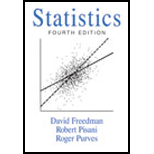
Concept explainers
a.
Calculate the average, the deviations from average, and the SD for given lists.
a.
Answer to Problem 7EE
(i):
The average of the given list is 2.
The deviations from average are 3, –6, 1, –3, and 5.
The SD of the given list is 4.
(ii):
The average of the given list is –2.
The deviations from average are –3, 6, –1, 3, and –5.
The SD of the given list is 4.
Explanation of Solution
Calculation:
(i):
The average of the given list is obtained as follows:
Thus, the average of the given list is 2.
The deviations from average is calculated as follows:
Thus, deviations from average are 3, –6, 1, –3, and 5.
The SD is obtained as follows:
Thus, the SD of the given list is 4.
(ii):
The average of the given list is obtained as follows:
Thus, the average of the given list is –2.
The deviations from average are calculated as follows:
Thus, deviations from average are –3, 6, –1, 3, and –5.
The SD is obtained as follows:
Thus, the SD of the given list is 4.
b.
Explain how the list (ii) related to list (i).
In what way the relationship carries over to the average, deviations from the average, and the SD.
b.
Explanation of Solution
From the given lists (i) & (ii), list (ii) is obtained by changing the sign of each entry of list (i).
Hence, average of list (ii) becomes negative. The signs of deviations from the average are also changes.
Since there is no change in the sum of squares of the deviations, SD of list (ii) remains same.
Want to see more full solutions like this?
Chapter 4 Solutions
Statistics
 MATLAB: An Introduction with ApplicationsStatisticsISBN:9781119256830Author:Amos GilatPublisher:John Wiley & Sons Inc
MATLAB: An Introduction with ApplicationsStatisticsISBN:9781119256830Author:Amos GilatPublisher:John Wiley & Sons Inc Probability and Statistics for Engineering and th...StatisticsISBN:9781305251809Author:Jay L. DevorePublisher:Cengage Learning
Probability and Statistics for Engineering and th...StatisticsISBN:9781305251809Author:Jay L. DevorePublisher:Cengage Learning Statistics for The Behavioral Sciences (MindTap C...StatisticsISBN:9781305504912Author:Frederick J Gravetter, Larry B. WallnauPublisher:Cengage Learning
Statistics for The Behavioral Sciences (MindTap C...StatisticsISBN:9781305504912Author:Frederick J Gravetter, Larry B. WallnauPublisher:Cengage Learning Elementary Statistics: Picturing the World (7th E...StatisticsISBN:9780134683416Author:Ron Larson, Betsy FarberPublisher:PEARSON
Elementary Statistics: Picturing the World (7th E...StatisticsISBN:9780134683416Author:Ron Larson, Betsy FarberPublisher:PEARSON The Basic Practice of StatisticsStatisticsISBN:9781319042578Author:David S. Moore, William I. Notz, Michael A. FlignerPublisher:W. H. Freeman
The Basic Practice of StatisticsStatisticsISBN:9781319042578Author:David S. Moore, William I. Notz, Michael A. FlignerPublisher:W. H. Freeman Introduction to the Practice of StatisticsStatisticsISBN:9781319013387Author:David S. Moore, George P. McCabe, Bruce A. CraigPublisher:W. H. Freeman
Introduction to the Practice of StatisticsStatisticsISBN:9781319013387Author:David S. Moore, George P. McCabe, Bruce A. CraigPublisher:W. H. Freeman





